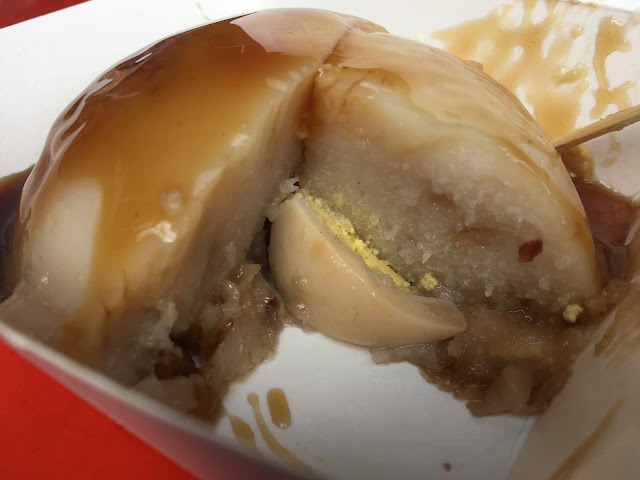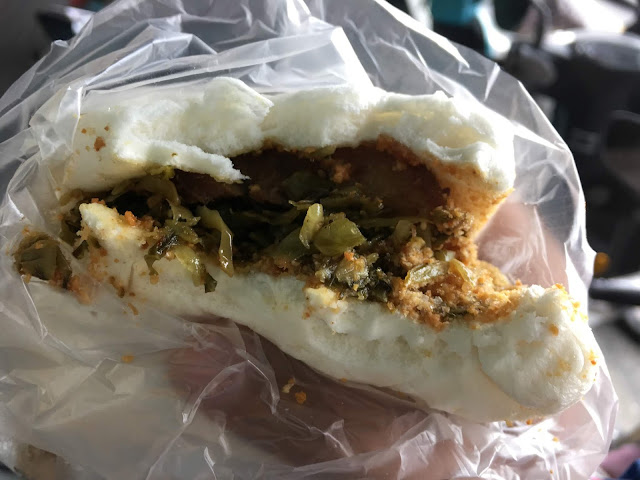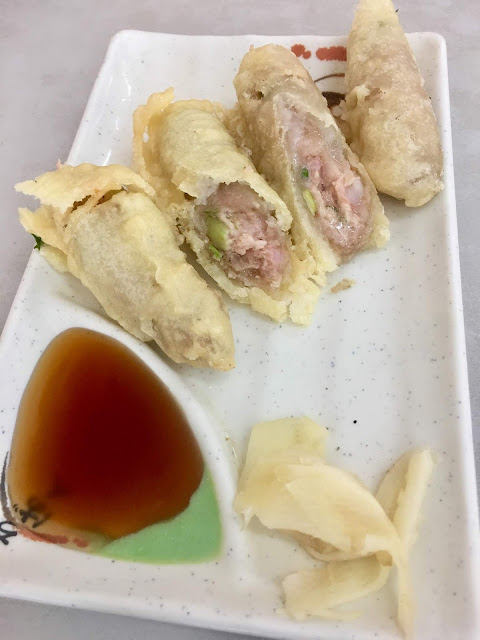1. Oyster omelette (蚵仔煎)
This dish originated from Teochew food (Guangdong, China), and variations of this dish are known in Taiwan and many Southeast Asian countries. The omelette is made of sweet potato starch with eggs, giving it a thicker consistency. The filling primarily consists of small oysters (sometimes substituted with small shrimps - shrimp omelette) and is topped with savory sauce. Oyster omelette is one of the most famous foods in Taiwan's night markets.


2. Steamed radish cake
Traditional radish cake (turnip cake) is one of the dim sum dishes. Turnip cake is made of Chinese radish (daikon) shredded and mixed with water and rice flour. You can also find variations of this dish that include minced meat, shrimps, and mushrooms. The cake is steamed (for about 1 hour), usually sliced when cooled, pan-fried, and served with soy sauce.3. Bowl cake (碗粿)
The rice syrup is heated on low heat and continuously stirred to prevent stickiness. It is then poured into a bowl, seasoned, and steamed. Common seasonings include rapeseed, minced meat, shrimp, and half eggs.4. Rice cake
Taiwanese bowl rice cakes originate from Tainan. Rice cakes are made by steaming glutinous rice, putting toppings like minced meat, mushrooms, and eggs on top, and steaming them again.




5. Stinky tofu (臭豆腐)
Stinky tofu is a form of fermented tofu with a strong odor that resembles rotten food. However, the flavor of this dish is unique and delicious. Stinky tofu can be eaten cold, steamed, deep-fried, barbecued, or cooked in mala sauce. There are many varieties of this dish, often served with pickled cabbage and chili sauce.


6. Meat ball (肉圓, rou yuan)
The meat, usually pork, is covered with a mochi-like dough made of glutinous rice mixed with potato flour. The filling can also contain other ingredients like chestnuts, bamboo shoots, mushrooms, etc. Rou Yuan is steamed, fried after cooling down, and served with sauce. According to legend, rou yuan was invented in 1898 in Beidou. The original version wasn't filled with meat, but people modified it over time. Now, every region uses different fillings and cooking methods.


The meat, usually pork, is covered with a mochi-like dough made of glutinous rice mixed with potato flour. The filling can also contain other ingredients like chestnuts, bamboo shoots, mushrooms, etc. Rou Yuan is steamed, fried after cooling down, and served with sauce. According to legend, rou yuan was invented in 1898 in Beidou. The original version wasn't filled with meat, but people modified it over time. Now, every region uses different fillings and cooking methods.


7. Sticky rice in bamboo tube
This aboriginal dish is not easy to find in street markets. It's sticky rice with minced meat cooked in bamboo tubes. This dish doesn't have much flavor but definitely looks special.



8. Seafood
Because Taiwan is surrounded by the sea, seafood is one of the main things you can find here. You can find seafood in different forms like cooked, fried, barbecued, or fresh.

9. Eggs, eggs, eggs...
Tea leaves eggs - Boiled eggs are cracked slightly and boiled again in a mixture of tea leaves, soy sauce, and five-spice powder. These eggs have a marbled pattern.
Salty duck eggs - Eggs are soaked in brine or salted charcoal, then boiled or steamed before being eaten. The flavor is very salty, so they are usually cooked with other foods as a flavoring.
Century egg - Preserved egg in a mixture of clay, ash, salt, quicklime, and rice hulls for several weeks or months. The egg yolk becomes dark green to grey in color, while the whites become dark brown. In this process, the yolk becomes green or grey with a creamy texture, and the whites become a brown jelly.
Tea leaves eggs - Boiled eggs are cracked slightly and boiled again in a mixture of tea leaves, soy sauce, and five-spice powder. These eggs have a marbled pattern.
Salty duck eggs - Eggs are soaked in brine or salted charcoal, then boiled or steamed before being eaten. The flavor is very salty, so they are usually cooked with other foods as a flavoring.
Century egg - Preserved egg in a mixture of clay, ash, salt, quicklime, and rice hulls for several weeks or months. The egg yolk becomes dark green to grey in color, while the whites become dark brown. In this process, the yolk becomes green or grey with a creamy texture, and the whites become a brown jelly.
This sausage made of sticky rice is often served together with a meat sausage inside, and it's called "small sausage in big sausage." This sausage sandwich was invented in Taiwan in the late 20th century.

11. Spring roll (春捲)
The fillings are usually cabbage, sprouts, and meat, rolled in popiah. This version of spring rolls is fresh, not fried.12. Gua bao (刈包)
Gua bao is made of steamed bread with fillings like braised pork, sauerkraut, peanut powder, and parsley. It is often called Taiwanese hamburger. The food comes from Fujian, China, but has been widely adapted in other Asian countries.13. Zòng zi (粽子)
Zongzi is a traditional dish made of glutinous rice with different fillings, wrapped in bamboo leaves, and then steamed or boiled. The filling and leaves used for wrapping can vary depending on the region. Zongzi may include chestnuts, mushrooms, egg yolk, peanut, and pork. Zongzi are traditionally eaten during the Dragon Boat Festival but can be bought all year round.14. Dumplings (餃子, Jiǎozi)
Dumplings are typically filled with meat or vegetables. Finished jiaozi can be boiled (水餃, shuǐ jiǎo), steamed (蒸餃, zhēng jiǎo), or pan-fried (煎餃, jiān jiǎo) and are traditionally served with a black vinegar and sesame oil dip.
15. Steamed buns: filled (报纸, Bàozhǐ), unfilled (饅頭, Mántou)
Baozi are a type of filled buns or bread-like dumplings. Baozi can be sweet or savory, filled with sesame, custard, meat, vegetables, and usually steamed. Mántou is the unfilled version of baozi.

16. Sweet potato balls (地瓜球, Dìguā qiú)
Mashed sweet potatoes are mixed with rice flour. The dough is then formed into small balls and deep-fried.
17. 蚵嗲 (he die)
This dish originates in Tainan and is made of oysters and seasonings like spring onion and sprouts with batter, then fried.18. Shrimp rolls (蝦捲, xia juan)
Made of shrimp with minced meat, covered with batter, and deep-fried.19. 鼎邊銼 (ding bian cuo)
It's a rice snack that originated in Fujian. Milled rice is mixed with water, steamed, formed, dried, and cut into pieces. It is usually served in a soup.






















0 komentarze:
Post a Comment